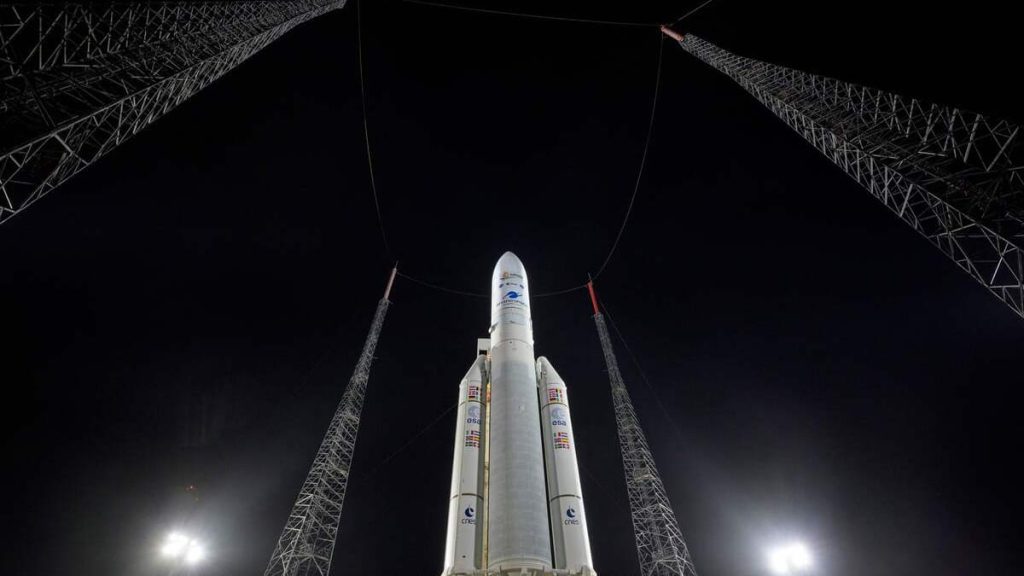
The James Web Space Telescope (JWST), the astronomers around the world who have been waiting for thirty years to explore the universe in unparalleled ways, will reach its observation post on Saturday with the Ariane 5 rocket 1.5 million km from Earth.
Also read: The launch of the James Web Space Telescope was confirmed on December 25
Also read: The takeoff of the James Webb Telescope was postponed for a few days after the “incident”
Also read: March: Perseverance ensures the relevance of the search for life
After taking off from the Guyana space center, scheduled for a 32-minute window from 12:20 GMT, JWST will become the most advanced cosmos-observing device launched into space.
Hoping to shed more light on two questions that plague humanity: “Where did we come from?” And “Are we alone in the universe?”.
Look at the lightning of the “Cosmic Dawn” when the first galaxies began to illuminate the universe from the Big Bang 13.8 billion years ago.
With a better understanding of the formation of stars and galaxies, it will be possible for astronomers to explore the exoplanets where most specimens have been discovered, perhaps locating another Earth one day.
James Webb follows in the footsteps of the Hubble Telescope, which made revolutionary changes in the observation of the universe: thanks to him scientists discovered the presence of water vapor around the galactic black hole or exoplanet in the center of all galaxies.
Predicted by NASA since Hubble’s launch in 1990 and built in 2004 in collaboration with European (ESA) and Canadian (CSA) space agencies, JWST differs in more ways than one.
Its mirror size, with a wingspan of 6.5 meters, gives it a surface area and is therefore seven times more sensitive, enough to detect a bumblebee’s thermal signature on the moon.
Another difference: its observation approach. Observing space in the light domain where Hubble is primarily visible, James Webb enters the wavelength that escapes the eye: near and medium infrared. Radiation emitted naturally by any body, star, human or flower.
This is studied by four instruments equipped with imagers and spectrographs to better disperse the light. Their development has brought together many engineers and scientists under the leadership of American and European laboratories and industrialists.
Thanks to this, astronomer Pierre Ferroot, co-scientific director of the telescope for the ESA, explained in Paris, “If we look at the same objects (including Hubble), we see new things.” For example, the first galaxies, objects that were remote, turned pale red. Or colonies of young stars growing in the dust clouds of their nurseries. Or the atmosphere of outer planets.
The ambient temperature required for the proper functioning of the JWST is very low, which does not interfere with light testing.
Hubble is about 600 km from Earth. At this distance, JWST is useless, heated by the sun and its reflection on the earth and moon. It will be placed at the end of a month-long tour of 1.5 million km. And five flexible mats protected from solar radiation by a thermal shield that dissipates heat, lowering the temperature (80 °) towards the telescope to -233 degrees.
But before it can get there, the machine and its designers must achieve real merit: its flawless expansion, for shield only, with a series of operations with 140 opening mechanisms, 400 pulleys and almost 400 meters of cables. .
Because the Observatory, with its 12 meter high and tennis court-like shield, had to be folded to slip into Ariane 5’s cap. “The Encapsulation” was carried out with laser guidance without any damage to the device, the development of which cost a few tens of billions of dollars.
For these maneuvers, the NASA Telescope also imposed strict cleaning measures to prevent contamination by mirror particles or even charged air …
Finally, ArianeSpace installed a tailor-made firing depressurization system so that when separated from the launcher, at an altitude of 120 km, a sudden pressure change would not harm the beast. “A + customer + extraordinary, extraordinary actions,” an ESA official in Kauro explained Thursday.
After 27 minutes we will know if the propelled phase of the flight went well. This would further close cooperation between NASA and its European partners. For space, ESA and NASA officials told Kauro that “strong cooperation is needed to achieve great things”.
However, it can take several weeks to find out if the telescope is ready for use. With official entry into the service scheduled for June.





More Stories
Allegations of corruption Qatar warns of ‘negative impact’ of European measures
USA: Famous “Hollywood cat” euthanized in Los Angeles
The campaigner who called for the shooting of Ukrainian children has not been charged